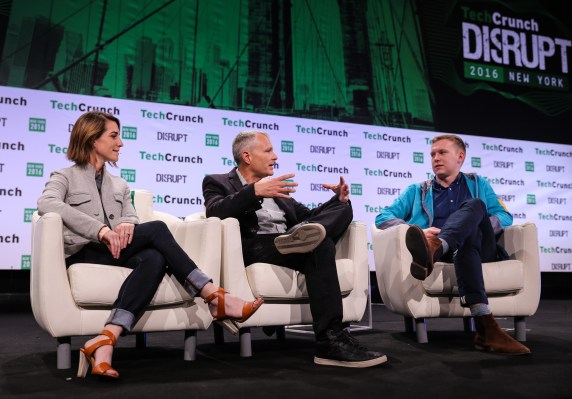Virtual reality can deliver on its promise to bring new and immersive experiences to the masses, but the current iteration of hardware will need to evolve first.
That’s the view shared by NextVR co-founder Dave Cole and Shanna Tellerman, co-founder and CEO of Modsy, two VR industry veterans who took to the stage at TechCrunch Disrupt NY to dig into the development of this much-hyped but potentially transformative medium.
Tellerman’s company, which raised $8 million in February, enables users to create a fully virtual version of their home for the purpose of testing out interior design styles or decor. That’s quite unlike the typical content associated with VR — such as games, sports or even pornography — and Tellerman believes it will take some time for VR to permeate beyond the typically white male users who own early versions of the hardware right now.
“The reality is that most consumers who [could benefit the most] don’t have VR in their living room yet. We have incredible technology in the background, and we’re designing every home so that, when VR hits, we can take advantage of it,” she said.
NextVR, which recently closed a $30.5 million Series A round, has struck deals with LiveNation and already covers a range of sports, including the Kentucky Derby and select NBA matches. Plenty of new features are in the pipeline, including positional tracking and movement, but Cole admitted he wants to expand his company’s range of programming.
“Content for a broader audience is a tricky issue, [we’re focused on] very pronounced silos right now. It takes critical mass, you have to hang that [content push] on [VR reaching a] critical mass,” he explained.
But, for those that experience it, there will be no turning back. “Once you’ve had that experience, anything else will feel like watching video in a fish bowl,” Cole added.
So what will it take for virtual reality to reach critical mass?
Aside from time, Tellerman and Cole both believe a new kind of hardware experience is needed. Fixed-home VR is showing the potential for the virtual reality and augmented reality content experience, but it is costly, unwieldy and uncomfortable. That’s kept it to a limited early demographic.
“We’re all very hesitant to put things on our face. The trend needs to start with trendy people… starting it in Silicon Valley… maybe sometimes works,” Tellerman joked. “Form factor needs to be something that hits the mark.”
“Form factors will need to change before it becomes mainstream,” Cole said in agreement.
The NextVR founder shared his belief that LG’s lightweight VR headset, LG 360 VR (a prototype of which was announced earlier this year), is the type of device that can move virtual reality into new kinds of audiences beyond early adopters. He also mentioned Microsoft’s HoloLens, which has shown early promise and has more than 1,000 engineers working on its development.
[gallery ids="1319679,1319678,1319676,1319664,1319667,1319669,1319668,1319665,1319666"]
“I think there’s a step beyond [headsets], whether it’s in our phone or our eyes, it won’t be a set of goggles sitting in our home,” Tellerman mused.
Both executives believe that VR is poised to be a genuine breakthrough, and not fall dead on its hype like 3D TV did.
“3D TV was a very small value add to the television experience,” said Cole, whose company was involved in TV, he explained. “VR engages your entire visual system in a way that 3D never did, [it is] immersive beyond anything that was possible… even an iMax theater.”
“3D goggles might [fail], but VR content creates a different level of immersion, it feels like we’re creating amazing businesses,” Tellerman said in agreement.
